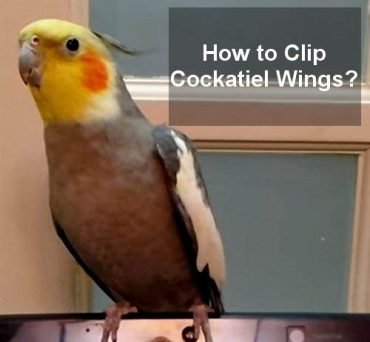
Clipping a cockatiel’s wings doesn’t hurt them if done correctly. It’s essential for not only their safety but also for your peace of mind. After all, you wouldn’t want your feathery buddy to take an unexpected flight and end up in a dangerous situation, right? So, grab your bird’s favorite treats and let’s dive into the gentle art of wing clipping and how to do it ethically.
Understanding Why Wing Clipping is Important
You might be wondering, “Why should I clip my cockatiel’s wings?” Well, clipping their wings is a preventative measure. Just like we wear helmets while biking, clipping can help protect your bird from potential hazards. If a cockatiel has full wings, they might fly into an open window, a fan, or even worse, escape your home entirely!
Here’s the thing: clipping wings doesn’t mean your bird will be grounded forever. It simply reduces their ability to fly high or long distances, allowing them to glide gently instead. This way, they can still showcase their unique personality and enjoy their space without risking accidents.
Additionally, if you have other pets—like a cat or dog—wing clipping can help keep your cockatiel safe from unexpected encounters. It’s a way of looking out for their well-being in a fun and loving environment.
Preparing for the Wing Clipping Process
Before you jump into clipping, let’s prepare. You want to create a calm and safe space for your cockatiel. First, gather your tools: a pair of sharp, clean bird scissors or nail clippers are essentials. Make sure the scissors are not too large, as you need to make precise cuts.
Next, grab some of your bird’s favorite treats. These will come in handy not just as a reward, but to help keep your cockatiel distracted during the process. Think of it like a little snack break while they get a makeover! Also, choose a comfy area to work in—somewhere quiet, free from loud noises or distractions. This will help calm your bird before the clipping begins.
Lastly, make sure you have a friend or family member with you, if possible. It’s always good to have an extra set of hands to hold the bird gently while ensuring they feel secure.
Steps to Clip Your Cockatiel’s Wings
Now comes the moment of truth! Here’s a step-by-step guide to safely clip your cockatiel’s wings.
Step 1: Secure Your Cockatiel
Gently hold your cockatiel with one hand, cradling their body while the other hand is free to work. Ensure you’re holding them securely but not too tight. You want them to feel safe, not frightened.
Step 2: Inspect the Wings
Before clipping, take a moment to look at the feathers. Identify the primary flight feathers, which are usually the longest ones at the very tip of the wing. You’ll be focusing on these.
Step 3: Start Clipping
With your scissors or clippers, cut the flight feathers about one-third of the way down. It’s better to cut less than more—you can always go back for another trim if necessary. Remember, you want to avoid the blood feathers, which are the ones with a little pink at the base that are still growing. Clip carefully, and take your time.
Step 4: Reward and Comfort
Once you’ve finished, immediately reward your cockatiel with a treat. This helps create positive associations with the experience. Give them some time to flap their wings a little and adjust to the changes. Make sure to provide lots of love and reassurance.
What to Avoid When Clipping Wings
While wing clipping can be beneficial, there are definitely some things to steer clear of. Avoid clipping too many feathers at once. If you take off too much, it can make your bird feel unbalanced, and that’s not what you want.
Also, it’s crucial not to clip the blood feathers. If you accidentally cut into these, it can lead to bleeding and a lot of distress for both you and your bird. Trust me, it’s like a bad hair day that nobody wants to experience!
Lastly, refrain from clipping wings when your bird is stressed or anxious. Time it when they’re calm and relaxed to ensure the whole experience is smooth.
Aftercare: Keeping Your Cockatiel Happy
After clipping your cockatiel’s wings, it’s essential to provide them with a lot of love and reassurance. Monitor their behavior in the days following the trim. They might seem a bit off at first, but that’s perfectly normal.
You can also enrich their environment with toys and perches at different heights to encourage them to explore. With their wings clipped, they’ll still want to climb and play, and giving them options helps keep them mentally stimulated and happy.
Don’t forget to conduct regular check-ups on their wings. As their feathers grow back, you’ll eventually need to reclip them. Keeping an eye on their growth helps maintain their safety.
When to Seek Professional Help
If you’re feeling nervous about clipping your cockatiel’s wings or you’re unsure about any steps, it’s perfectly okay to reach out for help. A vet or an experienced bird groomer can give you advice or even clip the wings for you. After all, it’s better to be safe than sorry!
Also, if your bird is older or has any health issues, consult a vet before attempting to clip their wings. They might have specific recommendations tailored for your pet.
Final Thoughts on Clipping Cockatiel Wings
Clipping a cockatiel’s wings might seem a bit daunting at first, but with proper preparation, the right tools, and a calm environment, it can be a safe and stress-free process. Remember, your goal is to ensure your feathered friend remains safe while still enjoying a happy, active life.
So, take a deep breath, gather your materials, and approach the task with care. Your cockatiel will appreciate the love and attention—and you’ll both feel more at ease knowing they’re protected while they flit about your home!
